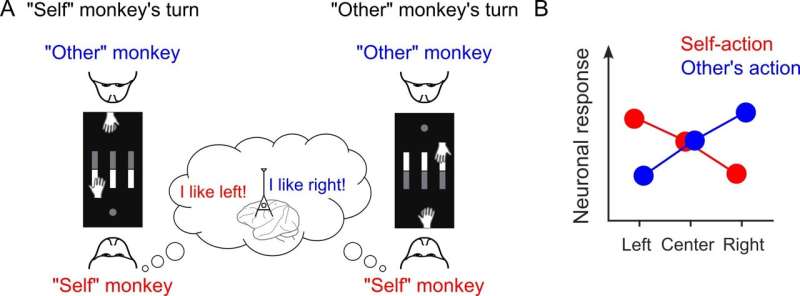This article has been reviewed according to Science X's editorial process and policies. Editors have highlighted the following attributes while ensuring the content's credibility:
fact-checked
peer-reviewed publication
trusted source
proofread
Neurons in the frontal cortex help macaque monkeys decode social interactions, study shows

By studying the brains of macaque monkeys during turn-taking exercises, researchers may be one step closer to understanding how individual neurons in the frontal cortex work together to analyze spatial locations of other individuals in social contexts.
The results were published in a paper in PNAS on July 24th.
"Understanding how social contexts impact the response properties of neurons provides a good insight into how our cognition and behavior are influenced by those social contexts," said Dr. Taihei Ninomiya, a researcher at the National Institute for Physiological Sciences at the National Institutes of Natural Sciences in Okazaki, Japan.
"This might also help us understand what happens when social information is not processed properly, which can be common in various neuropsychiatric disorders."
Previous research has shown that the neurons that encode observed actions of others as part of this social cognition process are found in the frontal cortex, especially the ventral premotor cortex and the medial prefrontal cortex.
To better understand the similarities and differences between these two regions of the brain, researchers observed the neurons in the ventral premotor cortex and the medial prefrontal cortex of macaque monkeys during a turn-taking exercise with three different partners: a real monkey, a filmed monkey, and a filmed object.
There was no difference in the number of neurons in each of the brain regions, but there was a difference in how the neurons responded to the different partners.
In the ventral premotor cortex, the amount of spatially tuned neurons did not change depending on the partner. However, in the medial prefrontal cortex, there were significantly more spatially tuned neurons when the monkeys were working with another live monkey instead of a filmed monkey or object.
When the monkey observed the live partner's actions during the exercise, they also found that a subset of the spatially tuned neurons in the medial prefrontal cortex mirrored the action of the partner monkey. Essentially, the neurons behaved as if the monkey itself was doing the action instead of its partner.
"We found a group of neurons with their spatial representations of self-action and others' action diametrically opposite. It is as if another person's action is seen from that person's perspective. These neurons may be involved in a cognitive operation known as spatial perspective-taking, in which one mentally rotates oneself into the position of others," said Dr. Ninomiya.
This type of response was greater when the partner was real instead of filmed, indicating that this spatial coding job of these neurons is more sensitive to real-time social interactions in the medial prefrontal cortex than in the ventral premotor cortex.
Looking ahead, researchers hope to understand more about the ventral premotor cortex and the medial prefrontal cortex and how they function as a network for social cognition.
"Ultimately, we would like to understand the neural basis of social cognitive functions and behavioral abnormalities caused by its dysfunction, as this helps us understand neuropsychiatric disorders such as autism spectrum disorder," said Dr. Ninomiya.
Masaki Isoda of the National Institutes of Natural Sciences in Okazaki, Japan also contributed to this research.
More information: Taihei Ninomiya et al, Dynamic spatial representation of self and others' actions in the macaque frontal cortex, Proceedings of the National Academy of Sciences (2024). DOI: 10.1073/pnas.2403445121




















